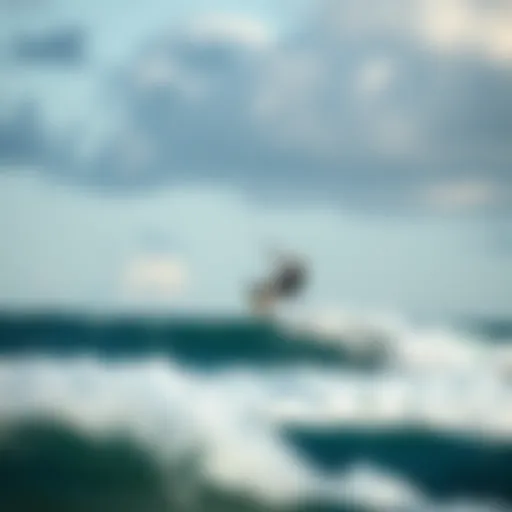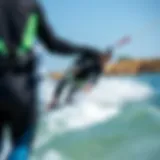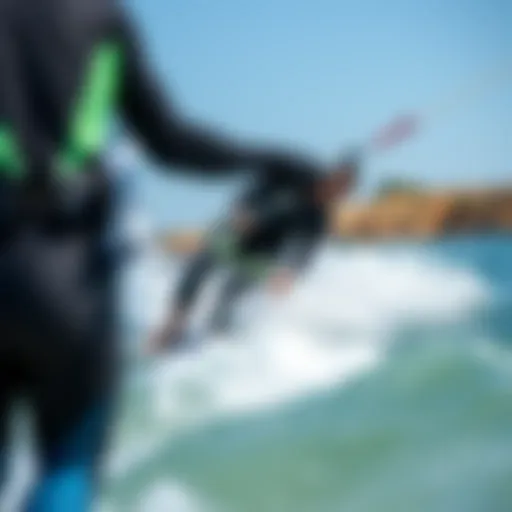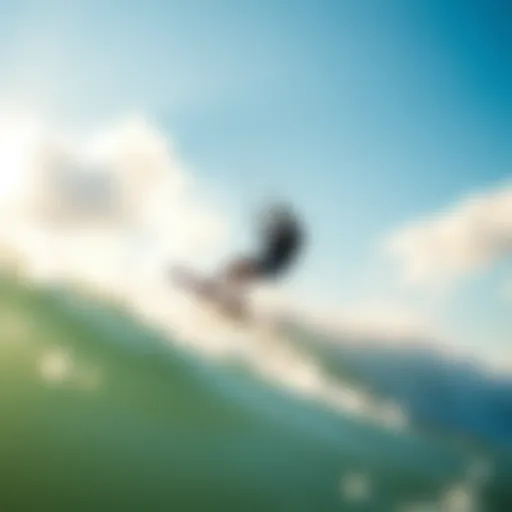Mastering Boat Surfing: Tips and Techniques
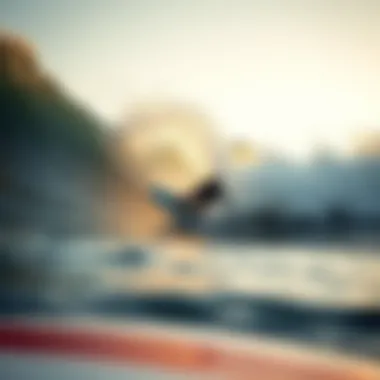

Intro
Surfing behind a boat brings a unique thrill that traditional surfing doesn’t always offer. Navigating through waves, feeling the pull of the boat, and striking a balance between control and freedom create an exhilarating experience. To some, this might seem like child’s play, but make no mistake; mastering this mash-up of water sports requires a solid understanding of various techniques, safety measures, and equipment choices. This guide is designed for both novices and seasoned surfers, focusing on the core aspects that make your time on the water enjoyable and fulfilling.
Whether you’re just getting your feet wet or looking to sharpen your skills, knowing what to do before you hit the water is crucial. By equipping yourself with the right knowledge, the transition from the beach to the boat will feel like gliding on butter. Let’s address the fundamental techniques that can elevate your boat surfing experience.
Techniques for Boat Surfing Enthusiasts
Beginner Techniques
As a beginner, the key is to keep things simple and focus on the basics. Here are some techniques that will help you get started:
- Posture: Maintain a slightly bent knee position. Your weight should be centered over the board, making it easier to handle waves and shifts.
- Grip and Stance: Your feet should be shoulder-width apart with your back foot closer to the tail. Distribute your weight evenly to help stabilize your ride.
- Rope Handling: Keep the handle in your hands, but don’t grip it like it’s a life raft. A relaxed grip lets you react quickly to pull from the boat and keeps fatigue at bay.
- Balance Drills: Practice your balance on the board while it’s stationary first. This can be done on land even to build muscle memory and intuition.
These foundational techniques will prepare you for the unique challenges boat surfing presents.
Advanced Maneuvers
Once you’re comfortable with the basics, it’s time to spice things up with some advanced maneuvers:
- Jumping: Utilize the wake created by the boat for aerial maneuvers. Timing your jump with the wave’s rhythm will yield successful hops.
- Spins: Practicing spins can enhance your agility. A front spin involves rotating 180 degrees while keeping your balance; back spins can be slightly trickier but are equally exhilarating.
- Grabs: Upon becoming confident in your jumping abilities, introduce grabs into your tricks. Reaching down and grabbing the board while in the air adds style and flair.
Progressing through these advanced techniques will not only impress your friends but deepen your connection with the art of surfing behind a boat.
Equipment Reviews
Board Reviews
A suitable board can be as crucial as your techniques. Look for boards that offer stability and responsiveness. Here are two noteworthy boards that have made waves in the community:
- Hyperlite 2022 Process: Known for its flex yet solid construction, this board is perfect for both beginners and those looking to refine their skills.
- Liquid Force Trip 2023: With its smooth riding and lightweight design, this board excels at maintaining speed and balance, especially suited for those aerial maneuvers.
Boat and Equipment Recommendations
When it comes to the boat, be mindful of its size and capability to create a consistent wake. A boat specifically designed for watersports usually makes a difference. For coaches and instructors, consider brands like MasterCraft or Nautique.
In terms of safety gear, don’t skimp out on life jackets or impact vests. A gear check is vital! Ensure your equipment is well-maintained and suited for the heights you aim to reach.
"Success is where preparation and opportunity meet."
Understanding the various techniques and the right equipment will fortify your boating experience and propel your skills forward. Whether it’s through simple practice or sophisticated maneuvers, your journey into the world of boat surfing will enrich your relationship with the water and the thrill that comes with overcoming challenges.
Prelims to Boat Surfing
In recent years, the thrill of surfing behind a boat has carved out a unique niche in the water sports community. Combining the excitement of traditional surfing with the controlled environment that a motorized vessel provides, boat surfing offers something special for both newbies and seasoned wave riders. It's more than just catching a wave; it’s about mastering the technique of riding a consistent wake, understanding the dynamics of boat movement, and connecting with nature in a seamless manner.
Understanding the Basics of Boat Surfing
To dive headfirst into this exhilarating sport, it is pivotal to grasp the fundamental principles of boat surfing. This encompasses not only how to stand up on a surfboard but also how the boat creates a wake suitable for surfing. Key elements include the boat's speed, the angle of the wake, and the type of board used. The boat needs to be moving at the right speed—usually around 10 to 12 mph—and the attitude of the boat can change the wave dynamics significantly. Surfers must also adjust their stance and body weight distribution to maintain balance through shifting waters.
"The right boat and surfer connection can create a wake that feels like a wall of water, making every ride a unique experience."
Understanding how these factors work together is crucial for safe and effective surfing. The experience becomes not just physical work but a dance with the water, demanding a good intuition of movement and timing. Collectively, these aspects contribute to honing one’s skills, which can lead to more advanced maneuvers down the road.
The Appeal of Surfing Behind a Boat
So what exactly makes surfing behind a boat so alluring? First, it is the accessibility. Unlike traditional surfing that relies heavily on ocean conditions, boat surfing allows a more predictable environment. This means dedicated surfers can practice any time, regardless of tides or wind conditions. Additionally, many find the community that forms in boat surfing circles alluring. Surfers often share tips, celebrate successes, and learn together, creating strong ties among enthusiasts.
Another significant appeal is the versatility of the sport. With the right boat setup, surfers can perform tricks or enjoy leisurely rides while floating through serene waters. The rush of carving through well-formed wakes often rivals that of riding ocean waves. Plus, the opportunity to explore different locations while surfing opens new doors to adventure.
Overall, boat surfing combines a blend of excitement, community, and accessible conditions that makes it a tempting option for anyone looking to get more involved in water sports. From beginners trying their hand at slipping and sliding to veterans perfecting their skills, the world of surfing behind a boat welcomes them all.
Types of Boats Suitable for Surfing
When it comes to surfing behind a boat, the type of vessel you pick can make or break your experience on the water. Selecting a suitable boat is not just about personal preference; it’s a strategic choice that can profoundly impact the quality of your ride and level of enjoyment. Different boats deliver distinct advantages in terms of wake quality, speed, and overall handling. Let's explore what sets them apart and why choosing wisely matters.
Wakeboard Boats
Wakeboard boats are often regarded as the gold standard for boat surfing. Their design is specifically tailored to produce a larger and more consistent wake. This is primarily due to their hull shape and how they distribute weight. For instance, these boats typically feature a V-shaped hull which helps channel the water in such a way that it creates a cleaner wake. This clean wake allows for smoother surfing, offering an ideal surface for surfers looking to maintain balance and perform tricks.
Key benefits of wakeboard boats:
- Wake Height: Elevated wake height gives surfers the opportunity for bigger tricks.
- Customization Options: Many come equipped with ballast systems that allow riders to adjust the boat’s weight distribution to fine-tune the wake.
- Built-in Features: Some models even have built-in bars and racks for storing surfboards.
In summary, for anyone serious about surfing behind a boat, investing in a wakeboard boat can substancially enhance your skills and enjoyment.
Inboard vs. Outboard
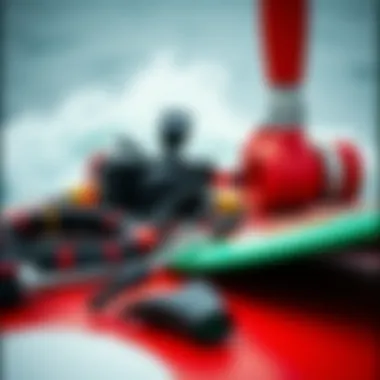

One of the more technical decisions you’ll have to make is choosing between inboard and outboard engines. Both have their merits, but understanding how they impact your surfing experience is vital.
- Inboard Engines:
Inboard engines are situated within the hull of the boat. They generally deliver a better wake and maneuverability. This is because the weight of the engine is centrally located, allowing for more seamless and controlled navigation. - Outboard Engines:
Outboard motors are mounted on the back of the boat, impacting its weight distribution. While they can be easier to maintain and repair, they often create more turbulence in the water, which can result in a less ideal surfing wake.
The choice here will depend largely on your specific surfing goals. If you're looking for the best performing and stable ride, an inboard boat may be the better bet.
Choosing the Right Boat for Your Needs
Selecting the right boat isn't solely about the type; it’s an amalgamation of various factors that reflect your individual needs and surfing style. Consider the following aspects:
- Number of Surfers: If you plan to ride with a crew, ensure that the boat has enough space and weight capacity.
- Experience Level: Beginners may prefer boats that are easier to handle, while more experienced surfers might appreciate the agility of a higher-performance vessel.
- Budget: Quality boats can range from budget-friendly to premium models. It's essential to balance features with price to ensure you get optimal value.
- Local Conditions: Consider the type of water where you'll be surfing—ocean, lake, or river—as it can dictate whether a certain type of boat is more suitable.
Remember: Take your time to weigh the pros and cons before making a final decision. The right boat can turn an ordinary day on the water into an extraordinary experience.
Essential Gear for Boat Surfing
When it comes to boat surfing, having the correct gear is as vital as the skills you bring to the water. The right equipment not only enhances performance but also plays a significant role in ensuring safety while you ride the waves. This section delves into essential gear that every boat surfer should consider, highlighting various types and features that help maximize the experience.
Surfboards: Types and Features
Choosing the right surfboard can feel like picking a favorite child—there’s just so much variation! Different boards are designed for specific styles and skill levels, impacting how you ride the wake. The common types include:
- Shortboards: These are nimble and allow for quick maneuvers, making them great for advanced surfers. They often have less surface area and require precise balance.
- Longboards: If you're new to the sport or prefer a smoother ride, longboards may be more your style. They provide stability and encourage a more laid-back surfing experience.
- Fish Boards: With a wider nose and shorter length, fish boards are excellent for pulling off tricks while still maintaining some stability.
Features to contemplate when picking a surfboard include the board's material, shape, and size. For example, a foam board might be more forgiving for a beginner, while a fiberglass board could provide the performance needed for a more seasoned surfer.
Safety Equipment: Life Jackets and More
Safety should never take a back seat. Every boat surfer must wear a life jacket, ideally a type that allows for ample movement, which is key when you're trying to catch a wave. Beyond life jackets, other vital safety gear includes:
- Helmets: Especially useful for those new to jumping and tricks, a sturdy helmet can prevent serious head injuries during falls.
- Impact Vests: These soft vests offer protection against falls while also providing buoyancy.
- Leashes: They prevent your board from floating away when you wipe out, allowing you to retrieve it easily.
Remember, wearing the appropriate gear doesn’t just safeguard your wellbeing; it enhances your confidence, allowing you to focus on mastering the waves.
Wetsuits: Choosing the Right Thickness
A wetsuit is a surfer's second skin, so selecting the right thickness based on water temperature is crucial. Different factors play into this decision:
- Water Temperature: For warmer waters (above 70°F), a thinner wetsuit (1-2mm) or a spring suit might do the trick. When temperatures dip down (between 60°F and 70°F), thicker suits (3-4mm) are favored to keep you warm without sacrificing mobility.
- Fit: A wetsuit should fit snugly without restricting movement. Consider trying different brands since sizes can differ remarkably.
TIPS:
- Always check the local water temperatures before heading out.
- If in doubt, it’s better to go thicker than thinner when the weather is unpredictable.
"The best equipment is where safety meets performance. Gear up right, and you’ll ride the waves with confidence!"
For further reading on safety and equipment, check out resources like Surfing Safety Guidelines and Wetsuit Thickness Guide.
Preparation for Boat Surfing
Preparation is the cornerstone of a successful outing in boat surfing. Setting the stage properly contributes significantly to both safety and enjoyability, while also enhancing your ability to master the sport. It’s not just about hopping onto a board and being pulled behind a speeding boat; it requires a thoughtful approach and a clear understanding of environmental conditions and equipment.
Assessing Local Conditions
Before you dive into the water, you need to take a hard look at the local conditions. Not every waterway is suitable for surfing behind a boat, and factors like wind, current, and water temperature can make or break your session. A choppy lake, for instance, can transform an exciting ride into a bumpy, uncomfortable experience.
- Wind direction: Understand how wind will impact the water surface. Crosswinds can cause waves to form, while headwinds may slow down the boat's speed, affecting the quality of the wake.
- Current strength: Strong currents can be a double-edged sword. They can help create larger waves, but they also pose a risk if the boat's speed isn’t properly managed.
- Weather factors: Keep your eyes peeled for upcoming storms or sudden changes in weather. Lightning doesn't give second chances.
By taking the time to properly assess these elements, you not only set yourself up for a more enjoyable experience but also ensure that you are prioritizing safety. As the old saying goes, "It’s better to be safe than sorry."
Setting Up the Boat for Surfing
Once local conditions are favorable, the next step is to prepare the boat itself. This may seem elementary, but a poorly set-up boat can lead to disappointing wake characteristics and even unsafe conditions.
A few pointers when getting the boat ready:
- Weight distribution: Balancing the weight on the boat is key to creating a good wave. Loading extra weight in the back can enhance the wake significantly. If you're alone, think about how you can rearrange gear or friends for optimal weight.
- Speed settings: Generally, a speed of 10-12 mph provides a sweet spot for an ideal surfing zone; too slow and you're dragging, too fast and you're risking a wipeout. It's best to experiment and find what works for you.
- Wake adjustments: Use the boat's trim tabs to modify how the hull interacts with the water. Raising the bow will generally create a larger wake, as it pushes more water behind the boat.
Getting everything dialed in can feel like fine-tuning a musical instrument—it's crucial for achieving harmony when hitting the water.
Creating the Perfect Wake
A well-formed wake is what sets surfing behind a boat apart from other water sports. It's the canvas on which you will express your skills. Here are some essential tips for creating the perfect wake:
- Boat Selection: As highlighted in earlier sections regarding boat types, a wakeboard boat is usually purpose-built to create the optimal wake for surf riding.
- Speed Consistency: Maintaining a steady speed is imperative. Changes in speed can create inconsistency in the water, making it difficult for the surfer to gain confidence.
- Angle of the Tow Rope: Adjusting the angle at which the rope is attached affects the shape of the wake. A deeper angle creates a taller, more defined wake, whereas a flatter angle may yield a wider and softer one.
"A great surfing experience begins with a proper wake. Think of it as your launching platform into creativity and style on the water."
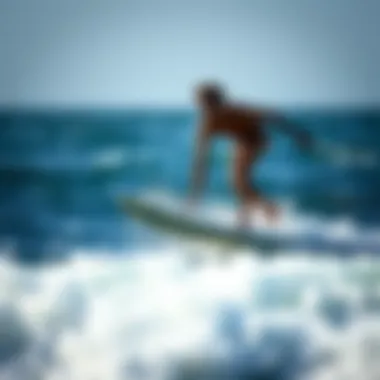

The preparation phase encompasses numerous nuanced factors that can dramatically improve or hinder your surfing experience. It's a blend of appropriating conditions, setting the right ambience on the watercraft, and crafting that perfect wave propelling you into your next adventure. Diving into boat surfing is not merely a thrill-seeking endeavor, but a complex symphony of interaction between man, machine, and nature. With thoughtful preparation, you'll be poised to ride the waves like a pro.
Techniques for Success
Mastering the techniques involved in surfing behind a boat is a crucial stepping stone for anyone looking to elevate their game in this thrilling water sport. Not only do these techniques refine your individual boarding skill, but they also create a platform to genuinely enjoy your time on the water—be it catching waves or executing those eye-catching tricks. From maintaining your balance to executing smooth starts and managing control while riding, each technique plays an essential role in enhancing your overall surfing experience. The insights discussed here serve as a guide tailored for kiteboarders, instructors, and water sports coaches who seek to develop a more profound mastery over this fascinating activity.
Finding Your Balance on the Board
Finding your balance is arguably one of the most important aspects of boat surfing. Without a solid foundation, every technique you try might feel like trying to walk a tightrope in a windstorm. The first step is to learn how to align your body correctly on the surfboard. Here are some considerations for achieving balance:
- Positioning: Your feet should be shoulder-width apart, with your back foot slightly over the tail. This stance gives you better leverage.
- Knees Bent: Keep your knees bent. This not only lowers your center of gravity but also allows for more fluid movement.
- Core Engagement: A strong core helps to stabilize your body. Think of it as the anchor that keeps everything from wobbling.
"Balance is not just standing still; it's about adapting to the motion around you, a dance between the board and the wave."
Practicing balance on dry land—standing on one leg or using a balance board—can aid in developing muscle memory too. It’s a simple exercise that pays dividends when you hit the water.
Mastering the Start
Once you're steady on your board, your next challenge is mastering the start. This is a critical phase that often sets the tone for your entire ride. If you fumble the beginning, it can throw off your rhythm.
- Grip the Handle: Hold on firmly to the rope handle. It needs to feel secure in your hands; this connection between you and the boat is vital.
- Timing: As the boat accelerates, you should lean back slightly and allow the board to start floating. Don’t rush; getting this timing right is key.
- Stand Up Gradually: Push off the water with your back foot, using your legs to rise gradually. A sudden motion could send you tumbling.
Each start might be unique, so take the time to experiment. Whether it's adjusting your grip or changing the angle of your body, small tweaks can lead to significant improvements.
Riding the Wake: Tips for Control
Once you’re in motion, riding the wake becomes the phase where everything you've practiced comes together. Control is paramount during this exhilarating part of the experience. Here are some tips that can help you ride that wave with finesse:
- Maintain a Low Center of Gravity: Keep your body low and lean into the wake. This stance provides better stability and control when making sharp turns.
- Use Your Edges: Apply pressure on the edges of the board to change direction or carve turns. This is where your earlier focus on balance pays off.
- Stay Relaxed: Tension can lead to mistakes. Stay loose and let your instincts guide you. Think of it as flowing with the water rather than fighting against it.
Riding includes finding the sweet spot where the boat’s wake is the highest. Sometimes, it might feel instinctual, but becoming aware of the wake's shape can lead to more extended and smoother rides.
In sum, refining your techniques will not only enhance your skills but also enrich your boat surfing experience. Balance, a smooth start, and control while riding the wake form the trinity of essential techniques every surfer should master to truly enjoy this thrilling sport.
Common Mistakes to Avoid
When hitting the water for a boat surfing session, avoiding missteps is crucial for both enjoyment and safety. Many surfers, especially those just dipping their toes into the sport, often fall into traps that can lead to poor performance or even accidents. By learning about common errors in advance, one can enhance their experience and minimize risks. Here are some key mistakes to sidestep while pursuing the exhilarating world of boat surfing.
Overthinking Your Movements
It’s easy to get caught up in your head, especially when you're learning to surf behind a boat. All that newfound information can turn a simple task into a mental labyrinth. Instead of enjoying the ride, you may find yourself overanalyzing every little movement.
When you start to overthink it, your body often tenses up. This rigidity can throw off your balance, making you less responsive. Instead, concentrate more on feeling the water and adjusting naturally. Learning to trust your instincts will yield a more fluid experience on the board.
Neglecting Safety Practices
Safety can often take a backseat to fun, but remember: no ride is worth putting yourself or others at risk. One common oversight is skipping the proper safety gear. Don’t just throw on a life jacket; make sure it fits well. A loose one won't be much help, and a tight one can be uncomfortable and distract you while you ride.
Additionally, be aware of local regulations regarding safety equipment. Most regions have guidelines that can help keep you safe. It's also vital to make sure everyone in the boat is aware of emergency procedures. Just as you wouldn’t venture into deep waters without a life vest, avoid heading out on the surf without proper preparation.
Failing to Communicate with the Boat Driver
The relationship between the surfer and the boat driver can make or break your surfing experience. If there’s poor communication, both parties may struggle, leading to a frustrating time on the water. Before you even hit the waves, ensure you establish clear signals.
A simple thumbs-up can denote "OK," while raising an arm may mean you need to stop. Discuss who will monitor the wake, speed, and direction. A slower pace might be more accommodating for beginners, while seasoned surfers may prefer faster starts. Open discussions can make everyone's day smoother and more enjoyable.
“Clear communication is like a lifeline in boat surfing—essential for safety and enjoyment.”
By keeping these common pitfalls at bay, you'll not only enhance your skills but also improve your overall enjoyment of boat surfing. Your journey on the water should be filled with exhilarating experiences, and sidestepping these mistakes can help make that happen.
Safety Considerations
When it comes to surfing behind a boat, safety should always be your first mate. Whether you’re a fresh face in the water or a seasoned pro, understanding safety considerations is crucial for a smooth ride. It’s not just about catching a wave; it’s about ensuring a secure and enjoyable experience for everyone involved.
Understanding Risks Involved
Every water sport has its own set of risks, and boat surfing is no exception. The sheer thrill of carving through the wake can sometimes blind you to potential hazards. Here are a few things to keep in mind:
- Water Depth and Obstructions: Before you take off, check the water depth. Shallow waters can be a recipe for disaster, especially when you’re trying to maintain balance on your board. Additionally, be on the lookout for submerged objects like rocks, logs, or other debris.
- Boat Traffic: When you’re out there on the water, remember you’re not the only player in the game. Keep an eye out for other boats, jet skis, and swimmers. Collisions can happen in the blink of an eye, and that can turn fun into a fiasco.
- Weather Conditions: Condition can change in a heartbeat. Strong winds, sudden downpours, or shifting currents can drastically impact how the water behaves. Always check the weather forecast before you head out. Ideally, choose a calm day; that's your best bet for safe surfing.
Emergency Protocols
No one wants to think about emergencies when they're out enjoying themselves, but having a plan can make all the difference. Here are some essential protocols:
- Establish a Clear Communication System: Ensure all riders know how to signal the boat driver if they encounter trouble. This could be a simple hand gesture or a whistle. Whatever it is, clarity is key.
- Wear Proper Safety Gear: Make sure everyone has a life vest that fits properly. No one is invincible, and a sudden fall can lead to serious trouble. Consider also attaching a leash to your board; it becomes a safety device in case you get separated from it.
- Know Rescue Techniques: Both the boat driver and surfers should be trained in basic rescue techniques—what to do if someone falls, how to approach them without creating wake. This could save a life.
- Have a First Aid Kit Ready: Always have a stocked first aid kit on board. Cuts, scrapes or even heat exhaustion can interrupt your fun, so being prepared is a wise move.
Importance of Spotting and Teamwork
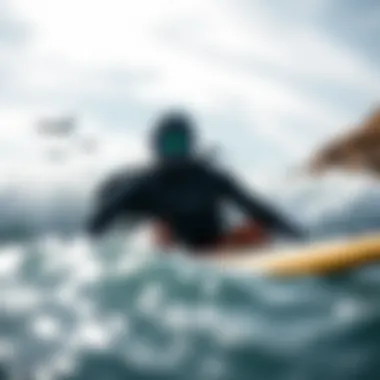

The phrase “two heads are better than one” holds especially true in boat surfing. Teamwork can enhance safety and improve the overall experience. Here’s why:
- Effective Spotting: Always have someone watching the surfer from the boat—a spotter. This ensures that someone is always aware of the rider’s position and can guide the driver to avoid potential accidents.
- Communication: Team members should talk about what’s working and what isn’t. A few minutes of feedback each session makes the group stronger. Feeling comfortable enough to share thoughts can adjust techniques for the better.
- Shared Responsibilities: Everyone should be clear on their roles. The driver has a big responsibility to keep the wake and speed consistent while the spotter keeps an eye on the surfer’s movements. Having defined duties can clear up confusion and promote safety.
"All hands on deck" is not just a saying, it’s a principle. Safety in boat surfing derives from teamwork, ensuring all members are tuned to the rhythm of the ride.
With these safety considerations in mind, you’ll have a solid foundation for your boat surfing adventures. Just remember, preparation is half the battle. Stay aware, stay prepared, and keep those waves rolling!
Exploring Advanced Techniques
As surfers grow in skill and confidence, advanced techniques become the next frontier that can elevate their experience behind the boat. Engaging with these techniques not only enhances a surfer's repertoire but also opens up a world of creativity and expression on the water. Mastering these skills can increase your ability to impress your friends, enjoy your time out on the water, and even contribute to your personal sense of achievement.
Jumping and Tricks
Jumping is pivotal in the realm of boat surfing. This art form allows surfers to push their limits while showcasing their skills. Successfully executing jumps involves several factors:
- Timing and Rhythm: Understanding the boat's speed and the wave's shape dramatically influences your jump. Catching the wave at the right moment makes all the difference.
- Pop Technique: This refers to the action of snapping the board off the water to gain height. Engaging your knees and popping your board at the peak of the wave is essential. Practice this technique on smaller waves before tackling larger ones.
- Landing: Achieving a smooth landing is just as critical as the jump itself. Maintain a low center of gravity by bending your knees, which can help absorb the impact.
"Jumping is where you find not just adrenaline but a deeper sense of freedom on the water. It's the moment when you can truly express who you are as a surfer."
It's wise to start with basic tricks before venturing into more complicated moves, such as spins or flips. Start by practicing small jumps and gradually work your way up. By combining spins or grabs with jumps, your performance becomes more dynamic, and helps develop individual style.
Switch Riding: A New Perspective
Switch riding, or riding the board in the opposite stance from your regular one, brings another layer of complexity to your boat surfing. While it might seem daunting at first, mastering this skill comes with several benefits:
- Improved Balance: Riding switch promotes better balance and stability as it forces you to engage new muscle groups. This can translate to improved performance in both regular and switch riding.
- Versatility: Knowing how to ride switch broadens your skillset and makes you a more versatile surfer. It can be especially helpful in competitions where adaptability is key.
- Enhanced Maneuverability: Surfing switch can add an entirely new dynamic to your trick repertoire. It encourages trying new tricks that might not have been within reach before.
To get started with switch riding, begin on calm days. Focus on positioning your feet correctly and maintaining a relaxed posture. As you become more comfortable, begin to incorporate some tricks that could be performed switch, fostering a deeper connection with your board.
Building these advanced skills takes practice, but with persistence, surfers can achieve new heights—literally and figuratively. Immerse yourself in the art and philosophy of these techniques, as they offer not just physical achievements, but also a richer experience on the water.
Building a Community
Creating a community among boat surfers is more than just forming social connections; it's a cornerstone for personal development and skill enhancement in the sport. Surfing behind a boat can often feel isolating, especially if you're new to the experience. By building a supportive network, surfers benefit from shared knowledge, collaborative learning, and collective motivation.
One of the key aspects of fostering a community centers around the idea of mutual support. When you connect with other surfers, you start exchanging helpful tips and techniques that can accelerate your learning curve. Someone might share a secret about how to create a better wake, while another might offer advice on selecting the right gear. This type of information exchange enhances everyone’s experience and compiles a pool of resources that can be invaluable.
Engagement with a surf community also enhances safety. With seasoned surfers around, beginners are less likely to find themselves in precarious situations. Having a buddy system in place not only ensures safety but also promotes accountability. Participants understand they are working together and are more likely to look out for one another.
Building connections extends beyond mere friendship. The collective spirit takes root in organized surfing events and competitions, which can serve as an enticement to improve one's skills and challenge each other positively. A sense of belonging can bring joy that may not be found while surfing solo.
In the realm of water sports, learning often goes hand-in-hand with practice, and having a community can facilitate consistent practice sessions where skills are honed, and advancements are celebrated.
Connecting with Other Surfers
Networking plays a pivotal role in establishing a thriving surf community. The value of finding fellow surfers cannot be overstated. Whether through local surf shops, online forums, or social media, building connections comes easier nowadays. Joining online platforms such as Reddit or Facebook groups dedicated to boat surfing can significantly broaden one’s network.
For instance, engaging in discussions or sharing experiences on Reddit can lead to invaluable insights. Social platforms facilitate meet-ups for surfers of varying skill levels, creating an environment rich in learning. Many surfers find joy in forging bonds that persist beyond the water, turning acquaintances into lifelong friends.
Attending local surf events or community gatherings provides an ideal opportunity for face-to-face interactions, promoting trust and camaraderie. Plus, those who participate in group activities often report a more enhanced surfing experience, as they can share both triumphs and challenges.
Participating in Events and Competitions
Events and competitions present thrilling opportunities not only for honing skills but also for solidifying community ties. They foster a friendly competitive spirit that drives surfers to push their limits. Engaging in local contests allows surfers to benchmark their capabilities against peers and learn by observing others.
On a grander scale, attending regional competitions can expose surfers to experienced participants and coaches who may offer tips useful for elevating one's game. Events often involve workshops that introduce new techniques and surfing innovations, further enriching the community's knowledge base.
Moreover, participating in these gatherings can reveal potential sponsorships for aspiring surfers, opening avenues for more serious athletic pursuits within the sport. It creates an atmosphere where dreams can be discussed, nurtured, and transformed into reality.
The End: The Continuous Journey of Improvement
The adventure of boat surfing doesn’t end once you catch your first wave; rather, it's a continuous journey filled with learning, adapting, and refining your skills. Each session on the water, regardless of your proficiency level, presents an opportunity for growth. Whether you’re a fledgling surfer or someone seasoned at tackling the waves, there’s always room to improve and expand your abilities. This is where the beauty of boat surfing lies—it's not merely about mastering a set of techniques, but about a holistic escalation of your craft.
The Importance of Continuous Learning
Participating regularly in this thrilling sport enhances more than just your surfing technique. You gain a deep understanding of the water, the powerful forces of nature surrounding you, and how to engage with your peers more effectively. Engaging in different conditions and styles of surfing motivates you to learn new tricks and refine your strategies. Each wave carved out serves as a reminder that the essence of this sport thrives on persistence and enthusiasm.
Learning never exhausts the mind, nor raises its voice.
Building a Support Network
Improvement does not happen in isolation. Surrounding yourself with fellow enthusiasts and instructors opens doors to new insights. A vibrant community serves a dual purpose: enjoying shared experiences and continually learning from one another. Taking part in workshops, local surf events, or informal meet-ups can enrich your understanding in ways you might not predict. It isn’t just about competing against one another but rather challenging each other to reach higher levels.
Evaluating Progress and Setting Goals
Maintaining a keen awareness of your progress is essential. Regularly assess your skills—what went well, and where you can improve. Setting tangible goals can significantly aid this process; aim for achievable milestones, such as mastering a specific trick or enhancing your balance on the board. Tracking your improvements can provide motivation and offer a clearer path for further advancement.
- Short-term Goals: Focus on immediate improvements, like learning to maneuver more confidently.
- Long-term Goals: Set ambitions for the season, perhaps mastering tricks that inspire you.
Embracing Challenges as Learning Opportunities
It’s vital to recognize that mistakes are part of the learning process. A wipeout doesn’t signify failure—instead, treat it as a stepping stone on your path to mastery. Each fall teaches you lessons about balance, timing, and technique. Embracing these moments builds resilience and sharpens your instinctive responses to the water’s behavior.



